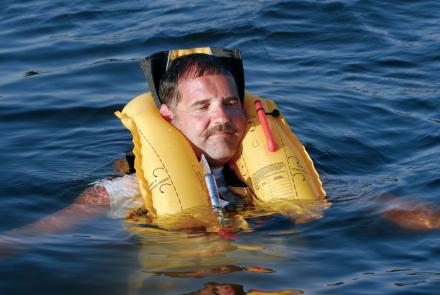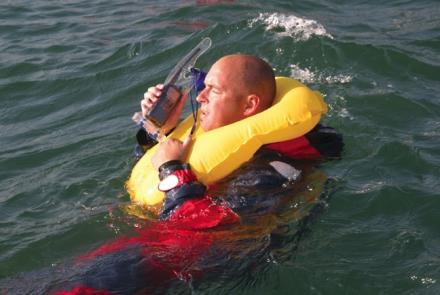Life Rafts and Abandon Ship
Larry Glenn, owner of Runaway, a J44 is very thoughtful, plus he is organized and disciplined about his thinking regarding emergencies. Larry knows that you cannot assign tasks in the middle of a crisis; you have to plan and organize ahead. Here is some actual planning Larry did before the 2012 Bermuda Race so his life raft would be ready and his crew would be able to deal with Abandon Ship issues. Larry doesn’t intend this as a complete discussion of all issues with life rafts, but rather a highlighting of important issues that are often overlooked. Here are Larry’s words:
SOME THOUGHTS ON LIFE RAFTS
Much has been written about life rafts and their use. This paper is about some very real observations made over many years of Ocean Racing. First, the care and feeding of a life raft is very important as are the unique characteristics of different models. Second is how difficult entering and organizing life rafts can be in the real world. A thought-through abandon ship plan that is crew specific is essential.
Life rafts need frequent service. We often say to the yard, "send it to be serviced" and feel we have done the job. The fact is that yacht life raft packing and service is an unregulated business and the quality of the services can vary a lot. You should find out who the servicer is and check him out. We had the unpleasant experience of finding that our servicer had stolen our rafts and substituted Junk of appropriate weight in the cases. (I now go to a repacker approved by my raft’s manufacturer.)
It also pays to go and watch the service being done with a couple of your crew. It takes the better part of a day for an expert to test the raft, check the inventory and replace out-of-date items, and finally repack the raft. It is a very detailed and skilled job. This also gives you and your crew a chance to see what the inflated raft looks like and what the equipment inventory is. This knowledge is an important element in developing your abandon ship plan.
I and four of my crew attended an "In the Water" training session last year. The training was well run and very realistic. The first shock is how hard it is to get in the raft. The second is the complete chaos that occurs after the raft is loaded. The experience makes one imagine how much worse it will be to do it at sea!
What we learned was that each vessel has to make an abandon ship plan that is based on the skills and athleticism of the crew. In loading the life raft, the first principle is to get your two youngest and strongest in the raft, to help with entry. The second is that the loading be orderly with each person going to their assigned place before the next entry. People should be loaded in order of agility and size. (In our case I am the biggest and least agile so it makes sense to get me in and maneuvered to my station first) finally, your Ditch Bag should contain all you need that is not already packed inside the raft.
You also have to have detailed crew assignments for all of the other abandon ship tasks to be completed.
These issues are real and deserve much thought in advance. A detailed plan should be in writing and all crew should study it. Below as an example are Runaway's abandon ship and life raft loading plans. This is serious stuff and should be treated accordingly!!!
Larry makes the important point that there are two moments where the person-in-charge will give orders that must be followed to the letter. First, when he orders the raft to be launched (but not boarded), and second, when he orders the crew to board the raft.
Larry shows two organizational plans below. One, when preparing rafts to go over the side, and a second at abandon ship time. By the way, the Runaway is a two-raft boat with two watches during a Bermuda Race. Page Break
The first organization plan shows who is at what station during a pre-abandon ship maneuver. The scenario here is that they have a damage control issue, like leaking from hitting a container at night.
|
|
ABANDON SHIP ASSIGNMENTS |
|
|
|
|
|
|
Starboard Watch |
OFF WATCH |
ON WATCH |
|
Greg |
Med Kit |
Helm |
|
|
|
Grab Bag 2 Lazarette |
|
|
|
Bottle 2 Lazarette |
|
|
|
Cockpit Bilge Pump |
|
Larry, jr. |
Bilge Pump After Head |
Drop Sails |
|
|
|
Help with Down Below Life Raft |
|
Toney |
Damage Control |
Damage Control |
|
Mark |
Grab Bag 1 - Forward hanging locker |
Drop Sails |
|
|
Bottle 1 Forward Hanging Locker |
|
|
|
Bag of water bottles Forward Hanging Locker |
Help with On Deck Life Raft |
|
Ian |
Down Below Life Raft |
Drop Sails |
|
D'Arcy |
Radio |
Radio |
|
|
Gather Nav. Gear |
Gather Nav. Gear |
|
Port Watch |
|
|
|
Larry Sr. |
Damage Control |
Damage Control |
|
Allison |
Med Kit |
Helm |
|
Will Copp |
Down Below Life Raft |
On Deck Life Raft |
|
Charlie |
Damage Control |
Damage Control |
|
|
Help with Down Below Life Raft |
Grab Bag 2 Lazarette |
|
|
|
Bottle 2 Lazarette |
|
|
|
Cockpit Bilge Pump |
|
Brandon |
Grab Bag 1 Forward Hanging Locker |
Drop Sails |
|
|
Bottle 1 Forward Hanging Locker |
|
|
|
Bag of water bottles Forward Hanging Locker |
Help with On Deck Life Raft |
|
Willets |
Bilge Pump After Head |
Drop Sails |
|
|
|
Help with Down Below Life Raft |
Wow, super organized. Every task is assigned, even down to who does what based on whether they were on- or off-watch. But no one has to debate what to do, and no task is undone - a necessity in an emergency.
The second plan involves the actual Abandon Ship evolution. Here is Larry’s plan:
ABANDON SHIP PROCEDURE
THE ABANDON SHIP EVOLUTION IS PROBABLY GOING TO BE SCARY AND CHAOITIC
However there are some principles of organization that can make a big difference:
-
If possible, board raft from the Runaway.
-
Have an Order of Boarding for each watch
-
Larry Sr.’s watch will use the raft in the valise. Larry Jr.’s watch will use the raft on the cabin top.
-
Two younger, athletic people must board the raft first to either hold the raft against the Runaway, or help people from in the water get aboard. On Larry Sr.’s watch Charlie and Brandon will board first. On Larry Jr.’s watch, Ian and Greg will board first.
-
Loading the rafts in an orderly manner is very important. The two “loaders’ will pull the next person on the raft. That person will immediately move to the opposite end of the raft to make room for the next. It is very hard to move around inside the raft, and there will probably be a lot of water in it. If you expect it to be absolutely horrible, you may be pleasantly surprised.
-
If loading from the Runaway, hand the grab bags to the “Loaders”. If the rafts are not right next to Runaway, be sure bags and bottles are clipped to the painters. As soon as people are on board, get bottles and bags into the rafts.
-
Wear life jacket, harness and tether when boarding; tether to the painter until you are in the raft.
Good Luck!!
In discussion, Larry emphasizes that it is important for the captain to be in charge of the order to board rafts, and to do so “by stepping up from the deck” of a sinking vessel. (Although escaping a fire may very well call for an earlier abandon ship order, he notes.) Larry’s ship Runaway also has a strict hierarchy of Person-in-Charge. Larry is skipper. If he is unable, then Anne Glenn is in charge. If they both are unable, then Larry Junior is in charge, etc.
In summary, every boat is different. You may have more or fewer aboard. You may have different equipment aboard. But all skippers need to plan ahead for abandon ship emergencies. From Larry’s notes you can see that involves careful selection and maintenance of your raft and complete outfitting of grab bags. Larry shows how you need to organize the hierarchy and duties during an abandon ship emergency, down to the smallest detail, like putting the strongest people in the raft first. This note should have you re-planning your evolution now.
CCA Contact: Larry Glenn



